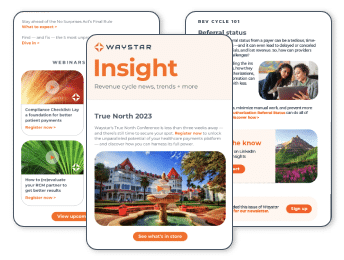Staying in compliance with the No Surprises Act (NSA) often feels like a moving target. Keeping up with changing regulations can be stressful for providers, especially when letting something fall through the cracks could have a substantial impact on your practice and revenue cycle.
With so much at stake, it can be difficult to navigate these complex regulations and make sure nothing is missed. We understand just how important it is to know what is — and isn’t — required to stay in compliance with the No Surprises Act.
As a reminder, always consult with your legal team, compliance department, or trade association for specific answers on how the NSA requirements apply to your organization.
Let’s take a deep dive into the NSA, so you can be prepared and ahead of the curve.
Why it matters
The No Surprises Act is intended to protect patients from surprise medical bills in situations where the patient has little to no control over who provides their care, including:
- Emergency care.
- Post-emergency stabilization.
- Non-emergency services provided by out-of-network providers at in-network facilities.
According to the NSA, doctors and hospitals must not bill patients more than the in-network cost-sharing amount for surprise bills.
While getting in compliance can feel like a hurdle, it’s important to remember the NSA helps patients as well as providers. As of June 2021, consumer records had $88 billion in medical debt, which can make the cost of getting care unaffordable for many patients.
With the NSA in place, patients will receive the care they need without going into debt, while providers will be better able to serve their communities and will be more likely to get paid.
Understand your role
As we navigate the No Surprises Act and the responsibilities of providers, it’s important to know the difference between a convening provider and a co-provider.
A convening provider or facility is the provider or facility that is responsible for scheduling the primary items or services. Convening providers or facilities are responsible for:
- Inquiring whether a patient is insured at the time of scheduling and, if so, whether the patient intends to use that coverage.
- Informing uninsured or self-pay patients of the availability of a Good Faith Estimate (GFE).
- Posting a notice of the availability of a Good Faith Estimate on their website, at the office, and on-site where scheduling or cost questions arise.
- Delivering the Good Faith Estimate either on paper or electronically, based on the patient’s preference.
A co-provider or co-facility furnishes items or services in conjunction with those furnished by the convening provider or facility. Co-providers and co-facilities are responsible for:
- Providing the required Good Faith Estimate within one business day of the request of the convening provider.
- Updating their estimate if they anticipate any changes to the scope of services.
- Ensuring that, if the co-provider changes less than one business day before the service, the replacement co-provider accepts the estimate of expected charges that have been previously provided.
Know the updates: what’s required
When it comes to the No Surprises Act, understanding the regulations is the first step of success.
For certain out-of-network scenarios, providers must charge in-network amounts to insured patients. This includes no balance billing for:
- Out-of-network emergency services.
- Covered air ambulance services by out-of-network air ambulance providers.
- Non-emergency services by out-of-network providers during patient visits to in-network facilities, unless notice and consent requirements are met.
In addition, providers and healthcare facilities must publicly disclose patient protections against balance billing.
For Good Faith Estimates, providers must give the estimate of expected charges to uninsured and self-pay patients at least three business days before a scheduled service, or upon request.
The GFE must be preserved as part of the patient’s medical record for at least six years, and a copy must be provided to the patient upon request during that period.
The No Surprises Act requires plans, insurers, providers, and facilities to ensure continuity of care when a provider’s network status changes. These entities must also implement certain measures to improve the accuracy of provider directory information as well.
Navigate the NSA: what’s not required
As you prioritize how to handle the NSA requirements, it’s also helpful to be aware of situations that don’t fall under the requirements.
If the patient is seeking healthcare services that are non-emergent and out-of-network — such as scheduling an elective procedure with an out-of-network provider — you don’t have to worry about balance billing. Balance billing rules also don’t apply if the patient signs the consent form to waive their protections.
In addition, you don’t have to provide a Good Faith Estimate for same-day or walk-in appointments due to the short turnaround time.
Even if it isn’t required, it’s still a best practice to have financial conversations with your patients. You can do your part to improve their financial literacy and build trust by:
- Anticipating their questions prior to service and at point-of-service. Because many people seeking care are concerned about surprise bills, this can help patients understand their charges and the amount due.
- Teaching your staff not to be afraid of financial conversations. Build trust with patients with a transparent + honest approach throughout their healthcare journey, including the billing process.
- Helping patients understand current charges and the amount due. Keeping the lines of communication open is an important step in providing compassionate financial care and fostering strong patient relationships.
Checklist for success
In addition to consulting with their legal team, compliance department, or trade association, providers can follow these basic steps below to stay on top of the No Surprises Act.
- Understand the applicability of the law in the state(s) where the facility/practice is located.
- Identify and benchmark current out-of-network payment trends and compare them to payments received after January 1, 2022.
- Identify process changes needed to support the IDR process.
- Analyze the cost of the arbitration process and consider bundling cases together.
- Ensure disclosures, consent forms and other documentation are compliant with the regulation.
- Don’t assume deadlines will get pushed.
- Understand the challenges and concerns identified with the regulation. AMA and AHA letters are good places to start.
- Keep updated on changes and updates to rule-making.
- Start internal training and implementation considerations.
- Use the delays in enforcement wisely for the Good Faith Estimate.
- Start planning necessary process and communication changes now.
- Work with your vendors to understand your NSA strategy.
Invest in the right RCM partner
As the NSA continues to evolve, it’s more important than ever to have a revenue cycle partner that has your back.
Waystar’s innovative, end-to-end platform helps make it easier to comply with the NSA, including smart tools to:
- Automate financial clearance and streamline the verification process with eligibility verification and coverage detection.
- Optimize patient payments, produce accurate and easy-to-understand statements.
- Provide compliant, accurate estimates for self-pay patients.
- Prevent denials and expedite recovery with denial and appeal management.
Although the No Surprises Act can be complex, taking proactive steps and partnering with a trusted RCM partner can help your organization stay in compliance — and ahead of the curve, too.
Find this post helpful? Learn all about Good Faith Estimates.


